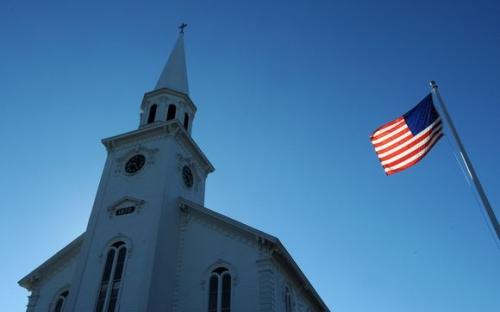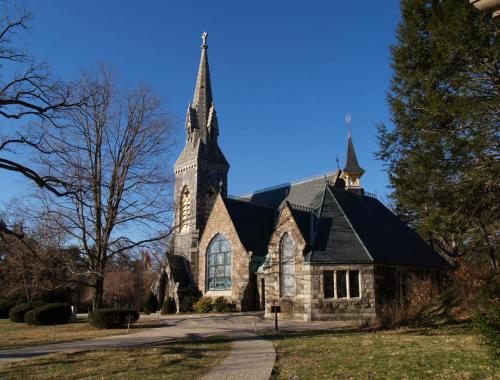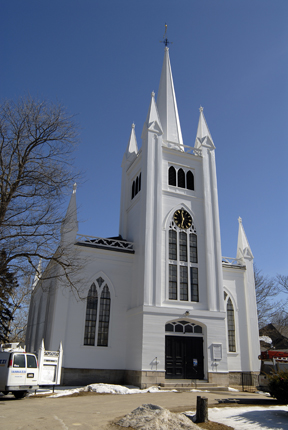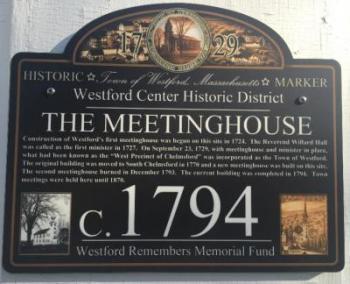Church Preservation Projects
 Many religious institution projects have been funded with CPA historic preservation funds across the Commonwealth with projects ranging in size from small, discreet repairs to complete rehabilitation. Churches played an integral role in the history of Massachusetts, and are also often local landmarks. Many houses of worship continue to serve broad community needs, providing space for public uses and activities such as daycare centers, musical events, girl and boy scout meetings, adult education classes, and the like. CPA funds can be a critical factor in successfully preserving and restoring these important historic community assets, but the Coalition is often asked about whether the use of public CPA funds for private religious institutions is allowable.
Many religious institution projects have been funded with CPA historic preservation funds across the Commonwealth with projects ranging in size from small, discreet repairs to complete rehabilitation. Churches played an integral role in the history of Massachusetts, and are also often local landmarks. Many houses of worship continue to serve broad community needs, providing space for public uses and activities such as daycare centers, musical events, girl and boy scout meetings, adult education classes, and the like. CPA funds can be a critical factor in successfully preserving and restoring these important historic community assets, but the Coalition is often asked about whether the use of public CPA funds for private religious institutions is allowable.
New England is known for its historic villages, which traditionally include a church and town green at their center. In addition, churches were often designed by noteworthy architects and builders in the most fashionable styles of their time and provide some of the best examples of period architecture in the region. Historic churches are often community icons, used as points of orientation and as centerpieces of illustrations and photographs.
That said, a decision made by the Massachusetts Supreme Judaical Court (SJC) in March of 2018 has established specific guidelines that communities must follow when considering providing CPA preservation funds to active religious institutions. While the case is still ongoing, the SJC determined that that communities must analyze potential grants under a three-factor test outlined in a 1981 SJC decision, Commonwealth v. School Committee of Springfield. According to the SJC, the decision should be based on the "purpose of the grant, the extent to which the grant aids the private institution, and whether the grant 'avoids the political and economic abuses' that led to the passage of the anti-aid amendment, all of which must be carefully balanced in determining its constitutionality.” It may be some time before the effects of this case are fully examined and understood, but you can click here to read more about the decision and how it applies to church preservation projects.
 The following examples illustrate how CPA funds have been used to preserve historic churches in Yarmouth, Easton, North Andover and Westford. Please note that these projects were approved prior to the SJC decision made as a result of the lawsuit in Acton in 2018.
The following examples illustrate how CPA funds have been used to preserve historic churches in Yarmouth, Easton, North Andover and Westford. Please note that these projects were approved prior to the SJC decision made as a result of the lawsuit in Acton in 2018.
Yarmouthport's First Congregational Church
With the help of $300,000 in Community Preservation funds, Yarmouth was able to complete restoration work on the town's First Congregational Church. The building, constructed in 1870, needed extensive renovations due to both its age and proximity to salt water.
For more information, read the Cape Cod Times article on this project.
Easton’s Unity Church
In 2006, Easton appropriated $380K of CPA funds for the restoration of the Gothic Revival style Unity Church, which was built in 1875 and is located on Main Street in the Village of North Easton. The church was designed by architect John Ames Mitchell, who later created Life Magazine. The church boasts Lafarge windows, interior renovations designed by Henry Vaughan, and an archway designed by HH Richardson. The CPA funds went towards structural reinforcement of the steeple, restoration of the roof and gutter system, and cleaning and repointing stonework. Phase II of this extensive project will focus on interior restoration work.
Click here to view photos from the restoration work.
 North Andover’s North Parish Church
North Andover’s North Parish Church
North Andover appropriated just over $141K of CPA funds in 2004 to restore the steeple and foundation of the historic North Parish Church. This project was part of a $2.1M renovation that included many building upgrades in addition to the historic restoration.
The church, which was constructed circa 1836, is located in North Andover’s Old Center. The church includes an 1807 Paul Revere Bell in the church steeple and a 1762 tower clock. Quoted in Merrimack Valley Magazine, Kim Adami, a member of the Unitarian Universalist congregation at North Parish, explains, “This church is an anchor for the historical section of town . . . When you see that steeple, you know you’re in an historic New England town.” Read the Merrimack Valley Magazine article on this project.
Westford's First Parish Church United
First Parish Church United in Westford existed before the incorporation of the town of Westford in 1729. In fact, the town could not incorporate without the church because, at the time, all towns were required to have a church and a settled minister. Westford's oldest  book, Reverend Hall’s record book, which details births, deaths and other important events that occurred from 1727-1779 in town, is housed at the church. Reverend Hall was a controversial figure in Westford because he was the only Tory in the town! While the church has undergone several changes over the years, the original bell was the fourth church bell cast by Paul Revere, a unique historical feature Westford is proud of.
book, Reverend Hall’s record book, which details births, deaths and other important events that occurred from 1727-1779 in town, is housed at the church. Reverend Hall was a controversial figure in Westford because he was the only Tory in the town! While the church has undergone several changes over the years, the original bell was the fourth church bell cast by Paul Revere, a unique historical feature Westford is proud of.
On March 27, 2010, the people of Westford generously voted to approve the use of Community Preservation Funds for handicap accessibility and historical archiving at First Parish Church. It was a monumental event in FPCU history, and it was a testament to the role the church played in the town’s history as well as the church’s continued involvement in town life such as Strawberry Festival, Apple Blossom Parade breakfast and so much more.
Further Resources
- MA Supreme Judicial Court Issues Decision in Lawsuit Concerning CPA Preservation Funds for Religious Buildings - March 2018
- The following article discusses a court case over the use of CPA funds for the restoration of stained glass windows at the Oak Bluffs' Trinity Methodist Church: "Judge Denies Injunction to Block Use of CPA Money for Church," Vineyard Gazette.
Mar. 2023

